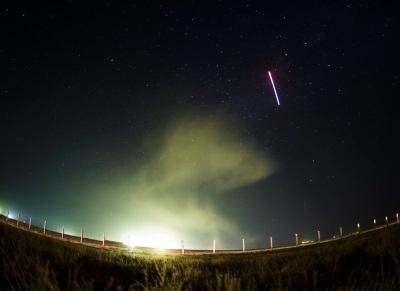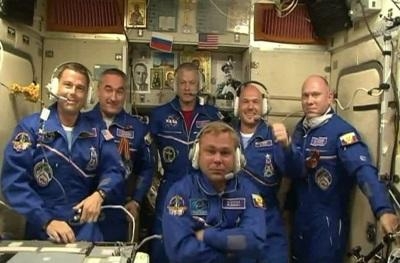Trio Boosted From Kazakhstan On A Six-Hour Flight To The Station Wednesday
Three new Expedition 40 crew members were welcomed aboard the International Space Station when the hatches between their Soyuz spacecraft and the station were opened at 2352 EDT Wednesday.

NASA astronaut Reid Wiseman, Soyuz Commander and cosmonaut Max Suraev of Roscosmos, the Russian Federal Space Agency and European Space Agency astronaut Alexander Gerst are slated to spend 166 days aboard the orbiting complex.
Commander Steve Swanson of NASA and Flight Engineers Oleg Artemyev and Alexander Skvortsov of Roscosmos, who have been aboard the orbiting complex since March 27, warmly greeted the newly arrived flight engineers. Afterward, all six crew members moved into the Zvezda service module so the station’s three newest residents could receive congratulatory calls from family members and VIPs gathered at the Baikonur Cosmodrome in Kazakhstan.
Wiseman, Suraev and Gerst launched from Baikonur at 1557 EDT (1:57 a.m. Thursday, Kazakh time) to begin a four-orbit chase to catch up with the station. At the time of launch the station was soaring at an altitude of 260 statute miles, just south of Karaganda, Kazakhstan, having passed directly over the Baikonur launch site just two minutes and one second earlier.
The Soyuz docked automatically to the Earth-facing port of the station’s Rassvet Mini-Research Module-1 at 2144 EDT as the complex was flying at an altitude of 262 miles and off the coast of northern Peru.
Some of the cargo flown aboard this Soyuz TMA-13M will be used in research investigations that are either ongoing or planned aboard the station.
The In-flight Demonstration of Portable Load Monitoring Devices-Phase I: XSENS ForceShoe (Force Shoes) investigation is an evaluation of the XSENS ForceShoe system as a potential method to measure exercise loads on the Advanced Resistive Exercise Device (ARED) during crew member exercise sessions on the space station. The XSENS ForceShoe is commercial, off-the-shelf hardware used to measure forces and torques under the foot. Up to four astronauts will collect a series of static and dynamic load measurements using ARED.
Researchers will use the measurements made by the XSENS ForceShoe system to quantify exercise load data needed for support of current and future human research investigations. This data also will be applied to populations on Earth restricted from exercise by injury, age, lifestyle or confined work and living space.
Questionnaires for the Space Headaches investigation also were delivered on the Soyuz to obtain in-flight data about the prevalence and characteristics of crew members' headaches in microgravity. Space Headaches researchers use this data to assess crew member headache episodes and provide the basis for developing future countermeasures. The effect of the medication that the crew takes to counteract space headaches helps determine what medication could be effective in treating intracranial pressure change related symptoms on Earth.
Equipment also was transported for the Multipurpose End-To-End Robotic Operations Network Quick Start a / Delay Tolerant Network (METERON) investigation. This European Space Agency technology demonstration examines the operational and technical capability to remotely control robots on Earth by astronauts on the space station. The study’s goal is to validate technology for future human exploration missions where an astronaut in orbit will control a robot as it explores its target, such as an asteroid or Mars. The remote operation techniques developed for METERON can be used on Earth for telemedicine and for operating robots in hazardous environments, such as in handling radioactive material or working in a nuclear power plant after a leak.

The crew will team up for a safety review to discuss emergency roles and responsibilities before wrapping up the day’s activities aboard the station. The entire Expedition 40 crew will have an off-duty day Thursday to shift its sleep schedules back to the usual 2 a.m. reveille beginning Friday.
The tenure of Expedition 40 will include a variety of research projects focusing on human research, biology and biotechnology, Earth and space science, physical science investigations, technology demonstrations and educational activities. Results from these activities will help advance the body of scientific knowledge, leading to potential Earth benefits such as improved weather forecasts and human medical advancements.
The hardware and samples for many of these experiments – along with crew supplies and other cargo – will arrive on four different resupply vehicles scheduled to visit the station during Expedition 40: Orbital Sciences’ Cygnus, a Russian Progress resupply ship, the European Space Agency’s fifth and final Automated Transfer Vehicle and the SpaceX Dragon.
There are also two Russian and three U.S. spacewalks planned during Expedition 40.
When Swanson, Skvortsov and Artemyev head back to Earth on Sept. 10, it will mark the end of Expedition 40 and the beginning of Expedition 41 under the command of Suraev. Three additional Expedition 41 crewmates will arrive later that month.
Wiseman, a U.S. Navy commander, is making his first spaceflight. He reported to the Johnson Space Center in Houston in August 2009 and completed astronaut candidate training in May 2011.
Suraev is making his second long-duration visit to the station, having logged more than 169 days in space as an Expedition 21/22 flight engineer from Sept. 30, 2009 through March 18, 2010. He completed a 5-hour, 44-minute spacewalk on Jan. 14, 2010, to prepare the Poisk Mini-Research Module-2 for vehicle dockings and inaugurated that same port when he relocated his Soyuz TMA-16 spacecraft there a week later.
Gerst, who was selected as an ESA astronaut in May 2009, is making his first trip into space.
(Images provided by NASA)
 ANN's Daily Aero-Term (04.26.24): DETRESFA (Distress Phrase)
ANN's Daily Aero-Term (04.26.24): DETRESFA (Distress Phrase) Aero-News: Quote of the Day (04.26.24)
Aero-News: Quote of the Day (04.26.24) ANN's Daily Aero-Term (04.27.24): Direct
ANN's Daily Aero-Term (04.27.24): Direct ANN's Daily Aero-Linx (04.27.24)
ANN's Daily Aero-Linx (04.27.24) Aero-News: Quote of the Day (04.27.24)
Aero-News: Quote of the Day (04.27.24)




